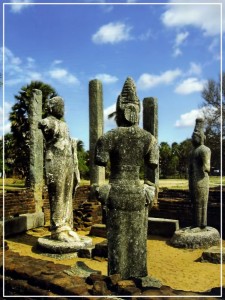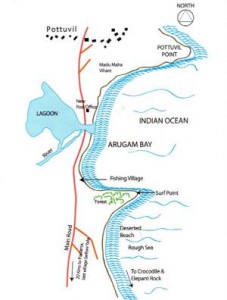Muhudu Maha Viharaya – PottuVille/ Arugambay
From Arugam bay to the pristine beaches of Panama
Sleepy lagoons, sand dunes
It took almost eleven hours from Colombo to Pottuvil on the narrow and winding A4 road along the south east coastline of Sri Lanka.
There were four of us; my husband and two of our friends. So far it had been a eventful day. We had watched the antics of a herd of elephants at theA?Lahugala sanctuary and had stopped to wonder at the historic ruins of theA?Magul Maha Vihara complex.
As we were approaching Pottuvil, the narrow road cut through acres of luxuriously green paddy fields. A milk white dagoba stood out over the fields framed by coconut and palmyrah trees. At the point at which we turned south towards Arugam bay was a small Catholic church dedicated to St. Anthony.
Our destination was Arugam Bay, a further 2.5kms south of Pottuvil.
We crossed the bridge over the wide lagoon of Arugam Kalapu. The roadside was dotted with hotels, guest houses, restaurants and may have resembled the southern beach line in its early days before tourism became an industry at the cost of the environment and the village culture.
Arugam bay is known as one of the best surf points in the world, popular for its challenging breaker laden waves. It may be one of the only unspoilt beaches in Sri Lanka.
Arugam bay Zoloft online ordering consists of three small villages where fishing and farming are the main occupations. Ullae is a fishing village situated at the corner of the bay with a natural harbour. It consists mostly of a Tamil population. There are a few Sinhalese families as well and the village boasts of both a Sinhalese and a Tamil school. Perie Ullae consists mostly of a Muslim population and has a sub post office, a mosque and a Muslim school. Sinna Ullae also consists mostly of Muslims and has a mosque and a Muslim school.
We booked into our hotel by the beach which offered us spotlessly clean private cabanas with thatched illuk grass roofs. Our Danish hosts welcomed us warmly. (Their homemade ice cream was out of this world) The thundering of the waves could be heard just outside our doors, which drove us to the sea and to a somewhat awkward sea bath, since the breakers show no mercy to amateurs, and we ended up with more sand on us than water.
We decided to spend the rest of the evening sipping cool beer and relaxing in one of the thatched beach huts by the sea. It was a picture perfect evening.
At the far end of the Pottuvil side of the bay, a brilliant rainbow dipped into the sea and then slowly dissolved into nothingness We sat late into the night making small talk and just listening to the roar of the mighty ocean, feeling the wind playing on our hair and watching a million stars begin to twinkle right over our heads and even a few shooting stars for a wish.
The next morning we went in search of the little known Mudu Maha Vihara excavated on the sea coast of Pottuvil. With no sign boards, we had difficulty in finding our way and a friendly young man, whom we learned was a school teacher, volunteered to take us to the site. Amongst massive sand dunes lies the evidence of a lost civilization.At night many fishermen appear from the villages with their lamps and wade into the lagoon to catch prawns. We walked closer to watch them and it was interesting to see them artfully throwing nets, which dazzled like silver dust in the darkness catching the light of their lamps before disappearing into the water. Once the nets were gathered, the prawns were emptied into holes dug in the sand on the shore. Each fisherman had a separate hole and kept his catch in it. Nobody spoke, the only noise was the lapping of the water at their feet, and the swirling of their nets. It was a brisk, serious business of throwing, gathering, emptying their catch and again throwing, gathering and emptying.
It is said that this is the place where Queen Vihara Maha Devi and her entourage were washed ashore and not at Kirinda. A brick boundary wall of an image house with many stone pillars included a well preserved statue of a Buddha and two Bodhisattva figures can be seen here.
Our new friend explained to us that the remains of many more ruins could be found under the sand dunes. He also showed us around the dunes and explained to us the various plant life. We were surprised at the healthy growth of the many stunted “Kohomba” trees. They were so green in contrast to the buff dunes. Climbing up and down the sand dunes was fun and it was possible due to the rain that had wet the sand and made a hard surface under our feet. The afternoon came to an end with our new friend inviting us to his home for lunch which unfortunately we could not accept due to other plans.
Another place of pristine beauty was the Panama beach which we decided to visit during the evening. The road leading about 17kms to Panama was itself full of contrasts. Flat green paddy lands, small rocky outcrops and shrub lands – a bird watchers’ paradise, marsh and beru grass fields and chena lands blended into each other. At one point we stopped to watch an unusual game of several crows giving chase to two eagles soaring high in the sky and from time to time dipping down as if to bully the poor crows. At another point we stopped to watch an elephant feasting on a meal of beru grass.
The motor road ends at the busy little village of Panama. A gravel road leads on to the beach passing a graveyard where most of the young soldiers who died in the war were buried. We stopped awhile to read the names, dates of birth and death of these young heroes, children of this humble village who had sustained the war efforts and the safety of millions who would never know to thank them.
The Panama beach itself was a paradise on earth. The sand dunes stretching along the beach made us stop our jeep and walk a short distance to the turquoise sea beach which stretched endlessly without a single sign of habitation. A typical Robinson Crusoe atmosphere. The pink rocks of Panama stood out at the far end of the beach. The evening sunlight made them glow pinker. Here too were monkeys running up and down.
The beach was covered with exquisite marine plant life. It suddenly dawned on us that this may be one of the only beaches left untouched by civilization and pollution. We were mindful not to tread on the plants or drive over them in our jeep. This beach with its abundant plant life must be saved for people to see and admire. It should not meet the fate of the Nilaveli or Passikudah.
We remembered the native American saying, “We did not inherit the earth from our parents, we are borrowing it from our children!”
Suddenly, much to our surprise, the sky darkened quickly. We could not see our jeep. Yes, we were lost amongst the sand dunes in pitch darkness, but yet it was so hauntingly beautiful.
Tricore sales training Ancient site nr. Arugam Bay
The Muhudu Maha Viharaya situated near Pottuville is over 2,000 years old. According to the resident monk, not much emphasis has been paid to protect this very ancient structure. There has been immense encroachment and much of this wonderful monument could be lost forever. Could it be that this Buddhist Monument is in the middle of a Muslim Community or the relevant authorities just don’t care.
The background to Muhudu Maha ViharayaA? could be foundhttp://www.nation.lk/2009/03/01/eyefea1.htm
We need to protect these treasures. Its history, it’s part of Arugam Bay and its things like these that make the place so wonderful and appealing to all people.


 Arugam Forum
Arugam Forum Arugam Photo Galleries on Picasa
Arugam Photo Galleries on Picasa Old Website
Old Website Press Coverage
Press Coverage Surf Forecast for Arugam Bay
Surf Forecast for Arugam Bay
0 Responses to “Arugambay: Like a Southern beach in its Early day”